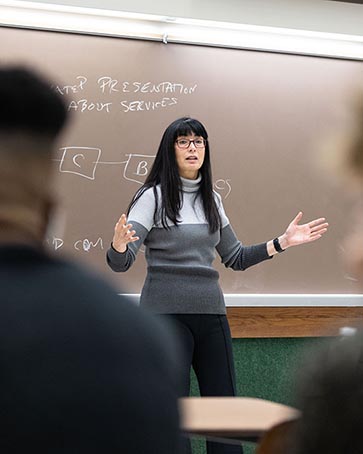Accessibility at PNW
PNW is committed to ensuring our electronic resources are accessible for the audiences who rely on them. Learn how we can all produce accessible web and app experiences.
It’s the Right Thing to Do…and It’s Required
Purdue’s S-5 Standard for Electronic Information, Communication and Technology Accessibility outlines how accessibility requirements apply to “electronic information, communication and technology that impacts students, employees and the public as it relates to university business and services.”

Requirements Are Changing
Deadline Ahead: April 24, 2026
The Department of Justice issued a revised ruling in April 2024 requiring that all web-based services, programs and activities offered by state and local government entities be accessible. This includes all student-facing digital content at Purdue Northwest.

New Emphasis: Instructional Materials
Instructional materials are among the materials that need to meet the updated accessibility guidelines. See resources from the Purdue system to help instructors meet this important goal.
Accessibility Is Everyone’s Responsibility
There isn’t a designated team to make documents accessible; that’s work we all need to do.
We do have resources below to guide you through the process. Here are a few big tips to get you started on the right path.
A common assumption is that content is “accessible” when it can be viewed on the web, shared in a link or downloaded.
The legal definition of “accessibility” is different, though. Is this instance, we’re referring to the Web Content Accessibility Guidelines (WCAG) 2.1 Level AA standards, a set of guidelines covering how to best make content accessible for individuals with disabilities.
These WCAG guidelines are considered the standard for accessibility compliance, including by the ADA Title II rule. Software and services evaluating accessibility will compare your digital content to these standards.
1. Plan Accessibility from the Beginning
It’s easier to plan accessible resources than it is to remediate them after the fact.
2. Build Around Headers and Subheads
Structured text is easier for all users. Avoid complex tables, which can be challenging to remediate.
3. Use Alt Text for Images and Graphics
You need to describe images for users who can’t see them. This applies to email too!
4. Check Your Work
Services like Microsoft and Adobe often have built-in tools to check for accessibility issues.

Frequently Asked Questions
Thank you to our colleagues at the Purdue University Fort Wayne Helmke Library for developing the following FAQs.
Web Content Accessibility Guidelines (WCAG) 2.1 Level AA standards are a set of guidelines published to make content accessible for those with disabilities. These are considered the best practices for accessibility compliance, including by the ADA Title II rule. For more information on WCAG 2.1 Level AA, please review their full guidelines: WCAG 2.1 Level AA
All digital media are required to comply with WCAG 2.1 Level AA standards. This includes webpage content, documents, videos, images, assignments, quizzes, and forums. All course materials that are shared with students should be fully accessible, including when printed. This includes materials such as PowerPoint slides, Word documents, Excel spreadsheets, PDFs, hand-written resources, and all web-based tools.
The consequences of non-compliance include legal action and fines, both for the university and for the person responsible for making the content available. Inaccessible content can also prevent users—especially students—from fully engaging with digital materials, including instructional content, which may limit their ability to participate in programs, access services and succeed academically.
Instructors, web administrators, application builders, and others who are responsible for making content available online and in courses (including in Brightspace) are responsible for selecting content that meets WCAG 2.1 Level AA standards before committing to using it.
If content from a third-party is not accessible and is not copyrighted, you may be able to make the content accessible before making it available online. However, if the content is copyrighted and cannot be updated, such as an article from a library database or publisher, then the responsibility is placed on the external tool and organization. This content should be linked to from the original source, not downloaded and uploaded into the Brightspace course or webpage.
There are few exceptions for online content to not have to meet WCAG 2.1 Level AA standards. These include preexisting (posted prior to April 2026) social media posts, archived and unchanged web content no longer in use and kept only for reference (such as digitized records or images held in a digital archive), and individualized documents pertaining to a specific person (such as a PDF of a tuition bill sent to a student).
For more information see “Summary of the Exceptions” in the ADA Fact Sheet.
Detailed Accessibility Resources
Digital Accessibility Skills – Purdue Libraries and School of Information Studies
Guidance and resources on seven core digital accessibility skills.
Accessibility: It’s About People – w3.org
The group behind the WCAG guidelines explains how accessible design can help all users.
Web and Content Accessibility – Purdue University Innovative Learning
Watch videos to assist you in creating accessible electronic materials.
Reporting Campus Accessibility Concerns
If anything prevents you from accessing a university program, activity, service or event, please let us know.
Accessibility Workshops
Nov 20
Instructional Material ADA Readiness – Introduction WorkshopIn this introductory session, we will discuss the resources available to instructors, demonstrate digital accessibility tools, and take questions from attendees.
Dec 19
Final Date: Instructional Material ADA Readiness Drop-In SessionsFrom Nov. 3 to Dec. 19, instructors can join live, informal support sessions to ask accessibility questions, troubleshoot challenges and get personalized advice in real time.
Campus Resources

This office enforces policies regarding equal access and equal employment and educational opportunity for all members of the university community.

The PAC empowers college-ready students with documented disabilities to participate fully in PNW.

Explore resources and opportunities to support faculty in their professional growth.